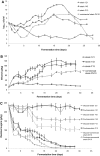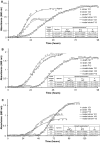Implementing principles of traditional concentrated grape must fermentation to the production of new generation balsamic vinegars. Starter selection and effectiveness
- PMID: 27777448
- PMCID: PMC5069243
- DOI: 10.1007/s13197-016-2306-9
Implementing principles of traditional concentrated grape must fermentation to the production of new generation balsamic vinegars. Starter selection and effectiveness
Abstract
In an effort to implement principles of traditional concentrated grape must fermentation to the production of new generation balsamic vinegars (BVs), the specific goals of the study were the isolation and molecular identification of the predominant yeasts in concentrated grape must (cv. Xinomavro), their technological characterization and the evaluation of the fermentative aptitude of the selected strains. Tolerance against 5-hydroxymethyl-furfural (HMF) and furfural, acetic acid and glucose concentration was examined by appropriate methods and tests. The enological characteristics studied were acetic acid and H2S production, foaming and flocculation ability and key enzymatic activity. PCR-RFLP analysis revealed only the presence of Saccharomyces cerevisiae and Hanseniaspora uvarum among the 14 predominant osmophilic yeast isolates. Tolerance to both HMF and furfural was found strain- and dose-dependent and was suggested as a critical factor in the pre-selection of yeast starters. The most tolerant yeasts to these stress factors, a S. cerevisiae and a non-Saccharomyces strains, showed satisfactory growth in the presence of high glucose and acetic acid content (up to 600 g/L and 2 % w/w, respectively) and desirable enological characteristics. Results from the comparative evaluation of the fermentative aptitude of these strains with a commercial wine strain highlighted that the isolates had glucophilic behaviour and ability to produce desirable amounts of ethanol (100-120 g/kg) in short time (~20 d). The key volatiles useful for varietal discrimination and differentiation between the BVs and the traditional ones were also evaluated.
Keywords: 5-Hydroxy-methyl-furfural tolerance; Balsamic vinegar; Concentrated grape must fermentation; Glucophilicity; Osmophilicity; Yeast starter selection.
Figures



Similar articles
-
Balsamic type varietal vinegar from cv. Xinomavro (Northen Greece). Optimization and scale-up of the alcoholic fermentation step using indigenous multistarters.Food Chem. 2018 Apr 1;244:266-274. doi: 10.1016/j.foodchem.2017.10.058. Epub 2017 Oct 12. Food Chem. 2018. PMID: 29120781
-
Acetic acid bacteria in traditional balsamic vinegar: phenotypic traits relevant for starter cultures selection.Int J Food Microbiol. 2008 Jun 30;125(1):46-53. doi: 10.1016/j.ijfoodmicro.2007.11.076. Epub 2007 Dec 5. Int J Food Microbiol. 2008. PMID: 18177968 Review.
-
Occurrence and enological properties of two new non-conventional yeasts (Nakazawaea ishiwadae and Lodderomyces elongisporus) in wine fermentations.Int J Food Microbiol. 2019 Sep 16;305:108255. doi: 10.1016/j.ijfoodmicro.2019.108255. Epub 2019 Jun 20. Int J Food Microbiol. 2019. PMID: 31252247
-
An optimized procedure for the enological selection of non-Saccharomyces starter cultures.Antonie Van Leeuwenhoek. 2011 Feb;99(2):189-200. doi: 10.1007/s10482-010-9475-8. Epub 2010 Jun 24. Antonie Van Leeuwenhoek. 2011. PMID: 20571862
-
Yeasts associated to Traditional Balsamic Vinegar: ecological and technological features.Int J Food Microbiol. 2008 Jun 30;125(1):36-45. doi: 10.1016/j.ijfoodmicro.2007.06.022. Epub 2007 Sep 4. Int J Food Microbiol. 2008. PMID: 17900732 Review.
References
-
- Cocchi M, Ferrari G, Manzini D, Manzini D, Marchetti A, Sighinolfi S. Study of the monosaccharides and furfurals evolution during the preparation of cooked grape musts for Aceto Balsamico Tradizionale production. J Food Eng. 2007;79:1438–1444. doi: 10.1016/j.jfoodeng.2006.01.091. - DOI
LinkOut - more resources
Full Text Sources
Other Literature Sources

